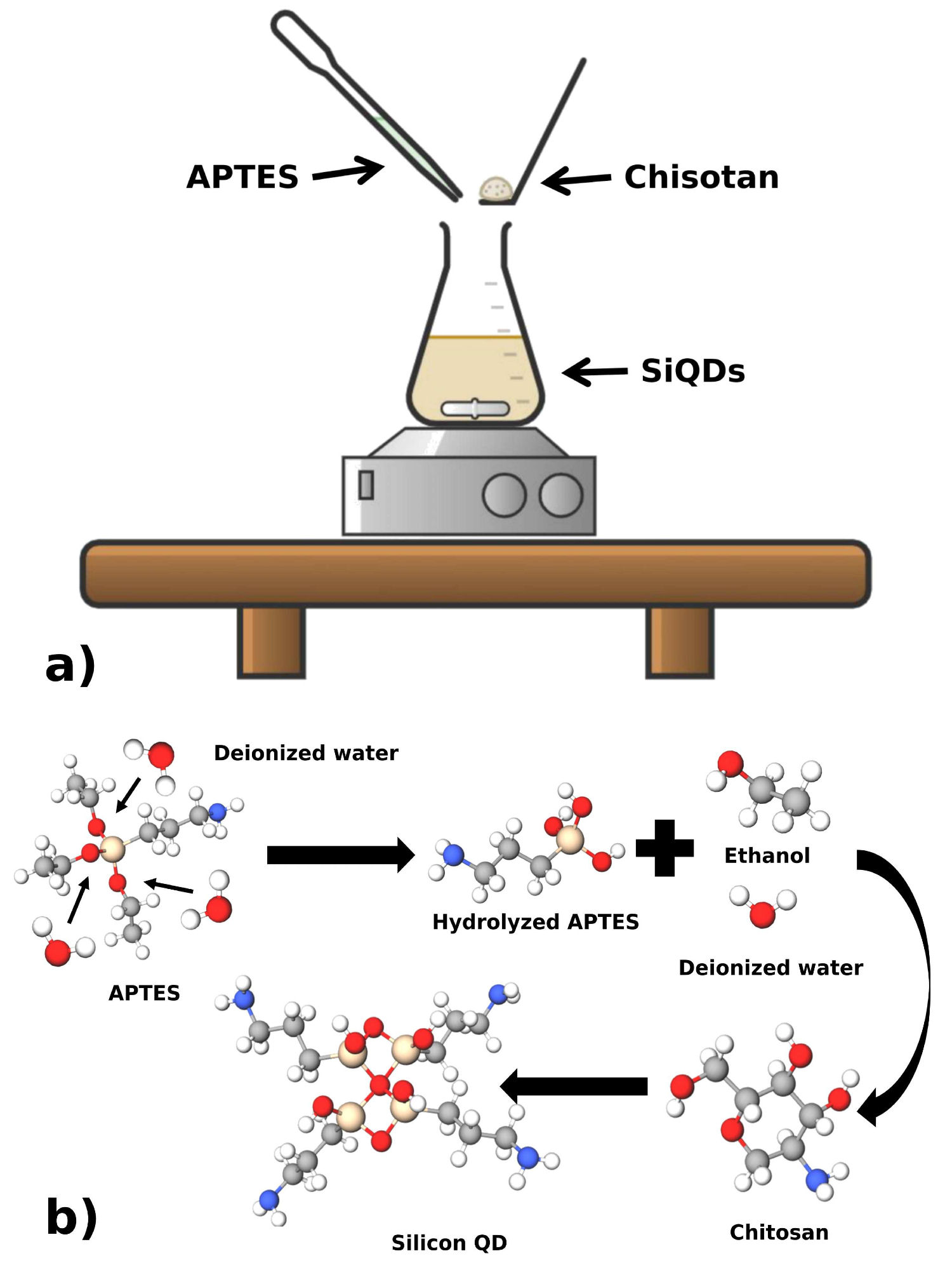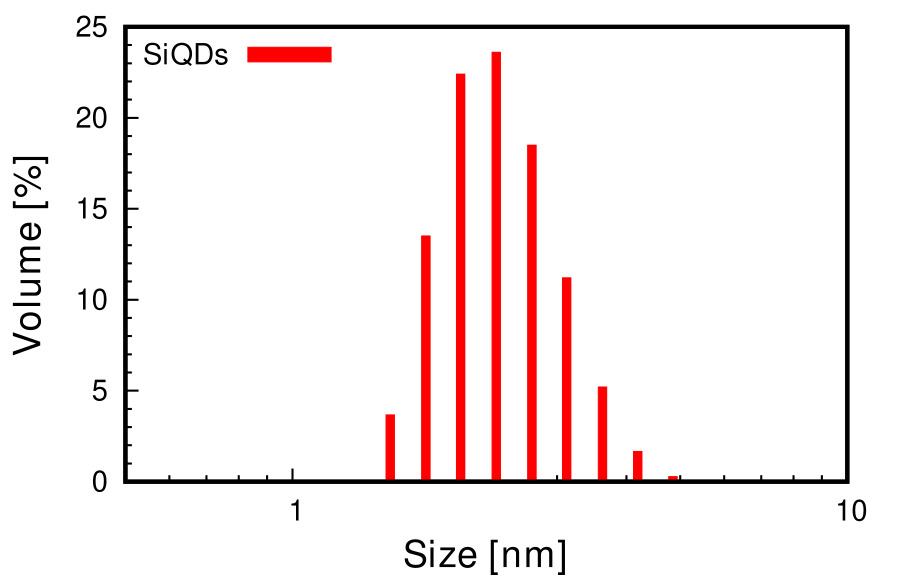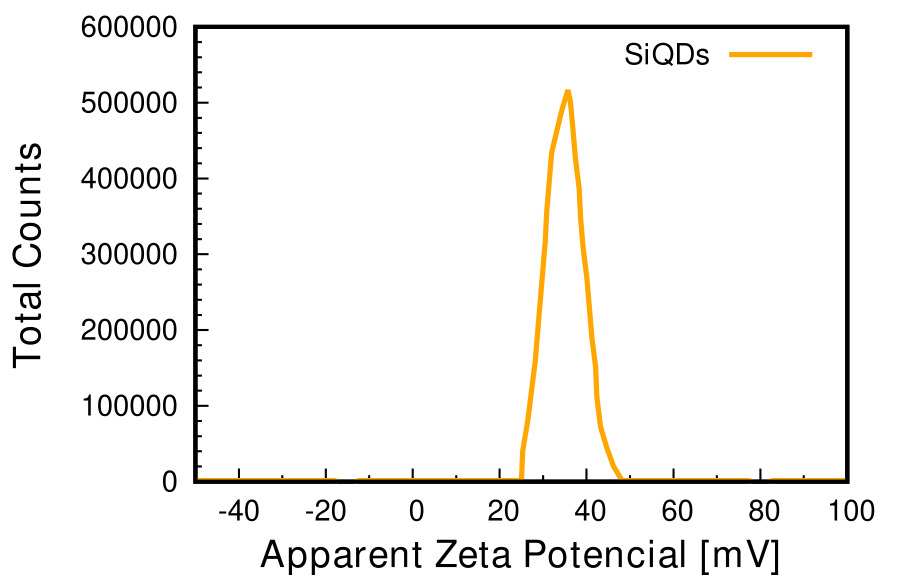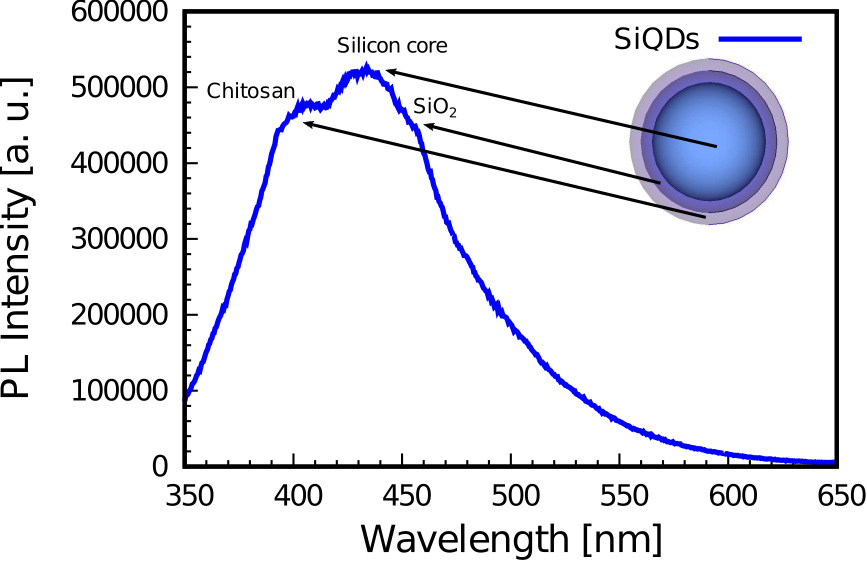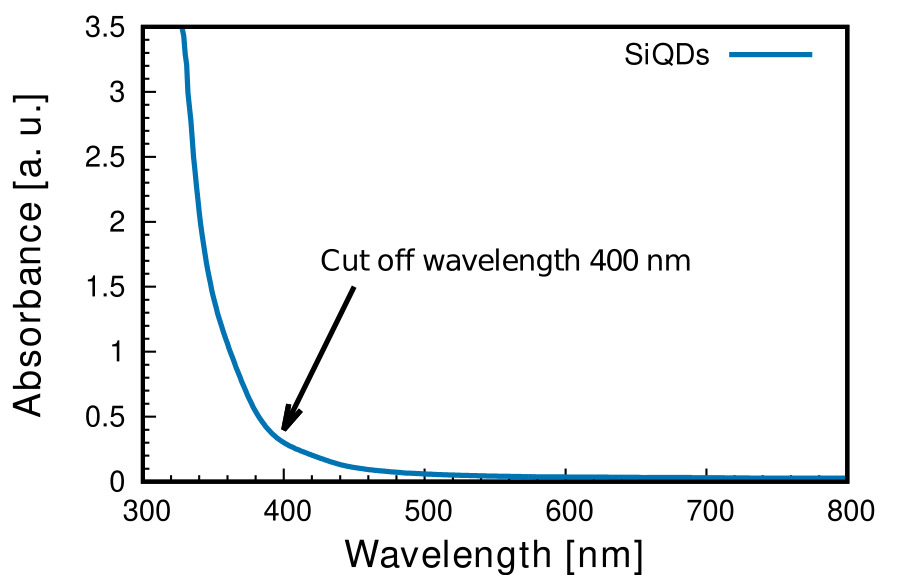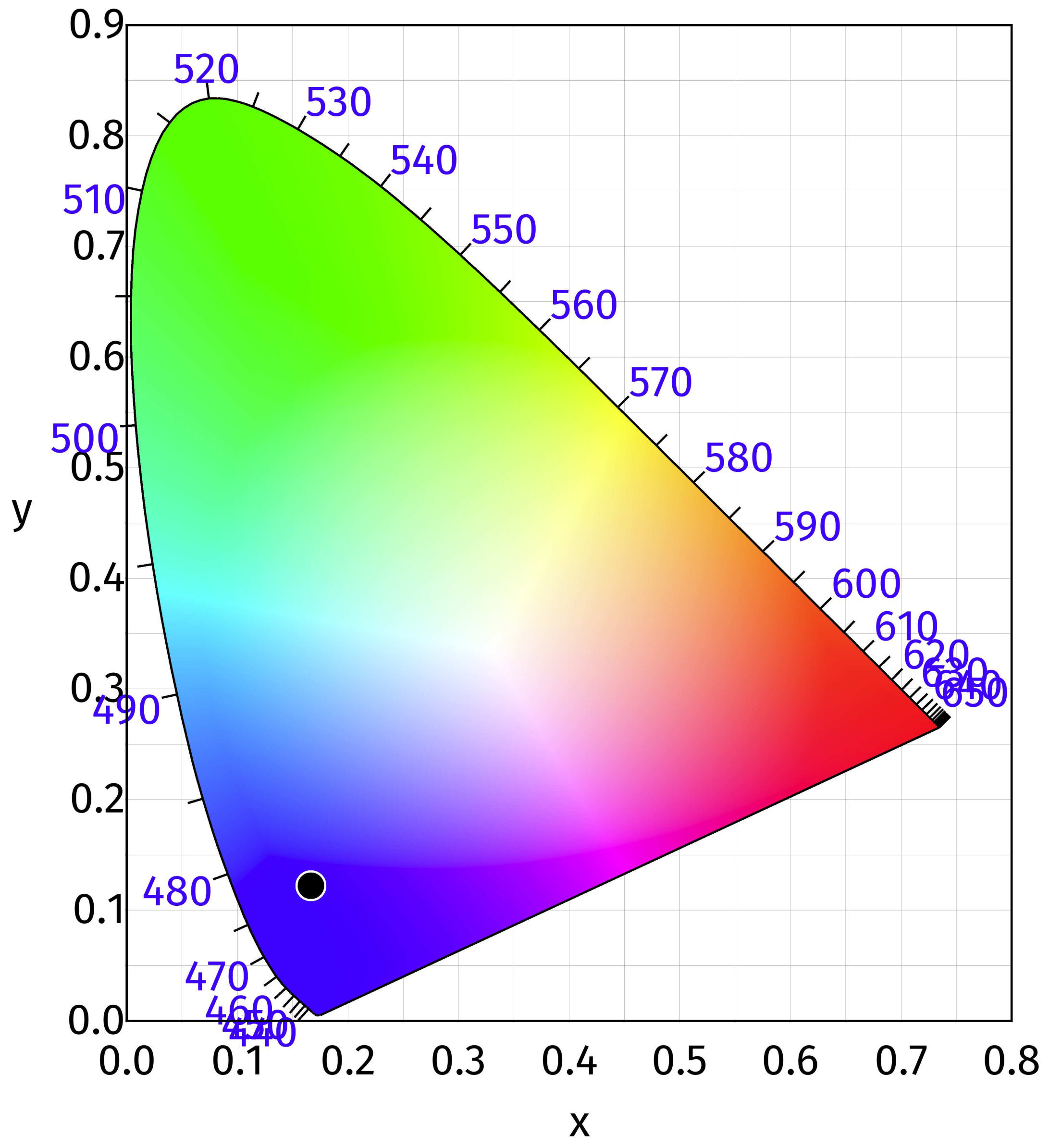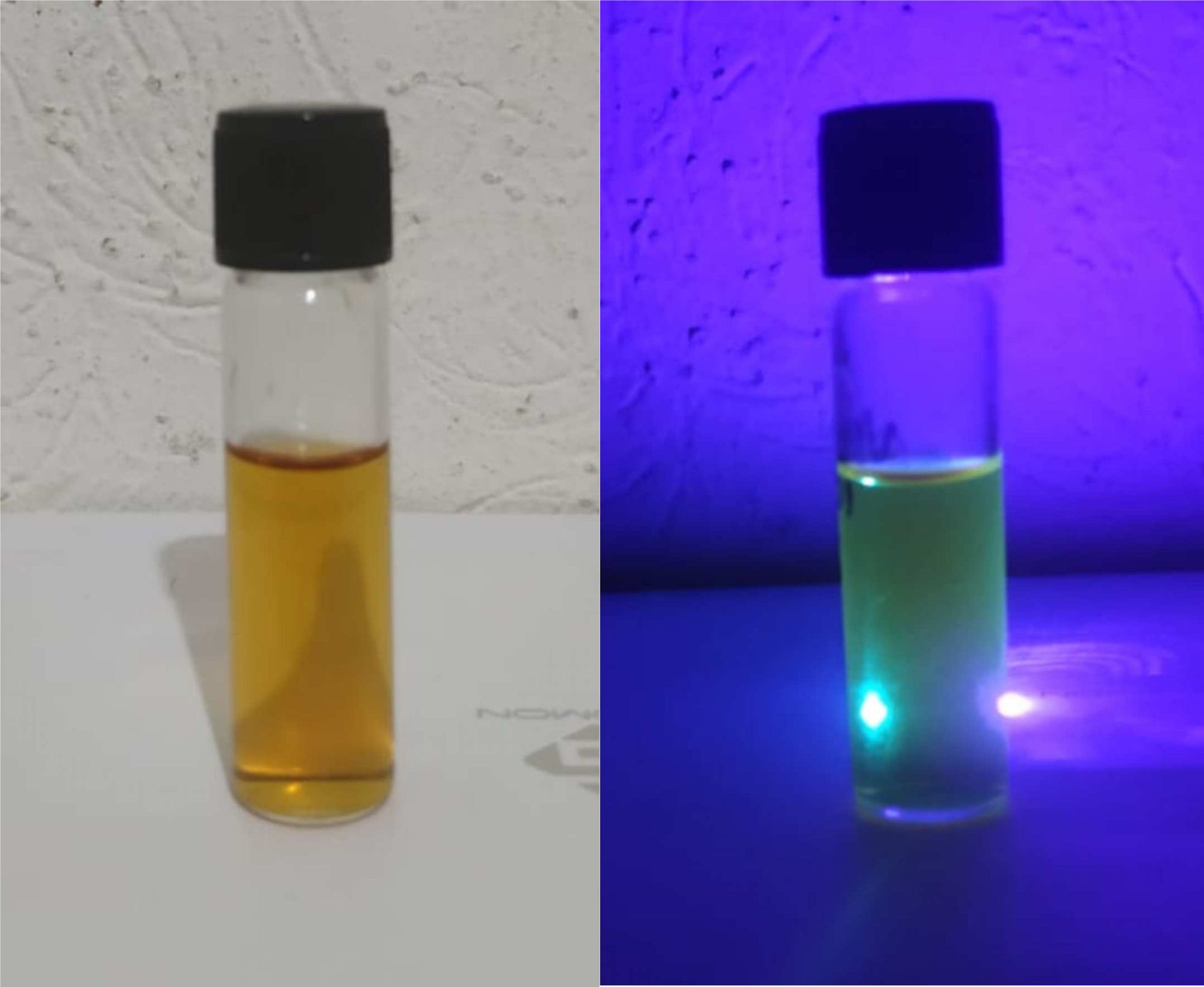1. Introduction
Silicon (Si) has been successful as an active material in the electronic industry. Its characteristic indirect band gap has limited the applications based on the emission of light. However, this semiconductor has recently drawn the attention of researchers due to its novel properties in the nanometric scale, such as tunable photoluminescence response [1], low toxicity [2], and biocompatibility [3]. The photoluminescence (PL) studies of nanostructured silicon have increased since the emission at room temperature on porous silicon films [4]. Silicon quantum dots have a wide range of potential applications; they have been used to improve the efficiency of solar cells [5], in the manufacture of light-emitting diodes (LED) [6], nonlinear optics, and secure communications cryptography [7]. The SiQDs have an extended fluorescence lifetime, according to multiples reports. This feature is particularly useful in cell imaging using fluorescencelife imaging microscopy [8] and bioimaging [9]. As a result, the amalgamation of these silicon quantum dots characteristics creates a new pathway for potential biomedical applications. Nowadays, silicon nanoparticles are commonly known as SiQDs. A significant breakthrough in this topic was the report that relates the luminescence from these SiQDs to their size and their electronic structure changes; the quantum confinement effect (QCE) is related to this phenomenon [10]. Therefore, investigations about new pathways for the synthesis of SiQDs have recently increased; the chemical and physical approaches are the core classification of synthesis techniques. The physical approach employs methods such as reactive sputtering [11], laser ablation [12], electrochemical etching and sonication [4], SiO2 implantation [13], and thermal annealing [14]. As a result, the PL emission for quantum dots (QDs) is in the range between 500 and 950 nm. On the other hand, the chemical approach applies processes as microemulsion synthesis [15], wet chemistry [9], synthesis in inverse micelles [16], and solution synthesis [17], which have produced QDs with an emission in the wavelength region from 300 nm to 500 nm [18].
In the search for new eco-friendly synthesis methods, one alternative is the replacement of the reducing agent. In previous investigations, polysaccharides as reducing agents in nanoparticles’ synthesis have been reported [19-21]. Polysaccharides exhibit characteristics such as high biocompatibility [22,23], low cost [24-26] and easy processability [27,28]. Polysaccharides possess functional groups in their structure, including amines, carboxyl, and hydroxyl. These functional groups participate in REDOX reactions, the synthesis, and stabilization of metallic nanoparticles being one of the most common applications [29,30].
Biopolymers, such as chitosan, have been used to search for eco-friendly and biocompatible reducing agents to synthesize nanoparticles. The essential characteristics of CS are its high biocompatibility, water solubility, and the high response of its functional groups to pH [31]. The properties of chitosan are beneficial in applications such as water bioremediation [32], cell scaffolding [33], and controlled drug delivery [34]. The presence of functional groups such as CH2OH and NH2 gives it properties to reduce metallic salts to synthesize metallic nanoparticles [35,36].
2. Experimental
Figure 1a) shows the schematic illustration of the process.
The synthesis of SiQDs uses the method described by Wang, changing the reducing agent to CS. [8]. For the synthesis, the conditions were ambient temperature and atmospheric pressure.
The method consists of hydrolyzing APTES in deionized water under magnetic agitation for 10 minutes. Then, a solution of CS (0.2 M) in deionized water was added to the previous mixture and stirred for an additional 20 minutes, as shown in Fig. 1b). In the next step, the resulting solution was centrifuged at 10000 RPM to separate the excess CS. The last step was collecting and storing supernatant for further characterization.
3. Characterization
The size distribution and ζ-potential of the SiQDs were measured with a Malvern Zetasizer NanoSeries. The photoluminescence spectrum was obtained using a Kimmon IK Series He-Cd Laser of 325 nm and a HORIBA Scientific iHR320 Spectrometer. The UV-vis absorption spectrum was measured using a PerkinElmer UV/Vis/NIR Lambda 19 spectrometer.
4. Results and discussion
4.1. Dynamic light scattering
Figure 2 shown the hydrodynamic diameter of the quantum dots in a colloidal solution, with an average of 2.3 nm. The size of the QDs is close to that shown in previous works to be highly biocompatible [37], [38]. A small particle size allows the QDs to be internalized by pathways that do not include energy waste (pinocytosis [39] or endocytosis [40]), which is a desired characteristic in cell markers.
4.2. ζ-potential
Figure 3 exhibits the SiQDs ζ-potential of +35 mV; the presences of amine groups in the APTES and CS are the cause of this behavior. The system reported by Wang et al., in which sodium ascorbate was used as a reducing agent, presents a ζpotential +30 mV [42]. The presence of a polymeric layer of CS on the surface of the QDs causes this difference. A positive character promotes cell internalization due to the electrostatic interaction between the QDs (with a lively character) and the lipid bilayer of the cell wall (with a negative character) [44]. This positive character is a desirable characteristic in cellular markers that require access to the cytosol.
4.3. Photoluminescence
Figure 4 shows the photoluminescence spectrum of the SiQDs at room temperature. We can observe the two characteristic emissions of the silicon core and the SiO2 at 434.5 nm (2.85 eV) [42] and 447.5 nm (2.77 eV) [43], respectively. The CS causes the third emission in 407.5 nm (3.04 eV), according to several works [47,45]. Therefore, we can propose a polymer layer of CS on the surface of the QD. The presence of CS increases the nanoparticle’s biocompatibility [46,47], which is highly desirable in biomedical applications. The figure inset shows a proposed schematic diagram of the kind, composition, and shape of the SiQDs.
4.4. Absorbance and band gap
Figure 5 shows the absorption spectrum of the SiQDs. The synthesized SiQDs show an absorption spectrum showed a robust cut-off wavelength at 400 nm. PerkinElmer’s simple method [48] and the band gap estimation was by the following Eq. (1) using the experimental absorbance values.
where: h is the Planck’s constant h = 6.626 × 10−34 J·s, C = Speed of light = 3.0 × 108 m/s, λ cutoff wavelength λ = 400 × 10−9 m and 1 eV = 1.6 × 10−19 J (conversion factor). The estimated value obtained for the band gap was 3.1 eV.
4.5. Comission Internationale de l’Éclairage 1931 chromaticity coordinates
The PL response of the SiQDs was characterized by CIE 1931 chromaticity coordinates [49], as shown in Fig. 6, obtained using the photoluminescence spectrum and the software ColorCalculator by OSRAM Sylvania, Inc. [50]. The SiQDs emit blue light (x = 0.1665, y = 0.1222) under UV radiation as shown in Fig. 7. This emission offers potential electronic applications such as down-shifting material on a solar cell’s window side to improve the photocurrent generation [51].
The use of CS as a novel silicon reducer for SiQDs synthesis has some advantages when compared to others as shown in Table I. Previous research reports the change particles surface charges and the biocompatibility increase by using CS.
TABLE I Comparison of SiQDs properties for similar synthesis pathways.
| Research’s authors | Size distribution (DLS) | Photoluminescence | Silicon source | Reductor agent |
| P.A. Hernandez-Abril, et al. | ∼2.3 nm | 447.5 nm 434.5 nm and 407.5 nm. | APTES | Low molecular weight chitosan |
| Jing Wang, et al. [8]. | ∼2.8 nm. | 530 nm. | APTES | Sodium Ascorbate |
| Jintai Lin, et al. [53]. | ∼3-5 nm. | 440 nm. | APTES | Trisodium citrate |
| Yiling Zhong, et al. [9]. | ∼3.86 nm. | 460 nm. | APTES | Trisodium citrate dihydrate |
CS has been used to change particles’ surface charge and increase their biocompatibility [52]. One of the benefits of using chitosan as a reducer is smaller particle sizes. In this work, CS has a double function: to be the reducing agent and functionalize the surface of the QDs.
5. Conclusions
The low-cost synthesis of SiQDs (does not require high priced equipment) and eco-friendly technique (room temperature and atmospheric pressure) was successful. In the synthesis, low molecular weight CS was used as a reducing agent. Its photoluminescent properties and size can be used as fluorescent probes, solar cells down-shifting coatings, and bio-sensors. The nanoplatform has a core-shell structure in which the CS is on the surface. The positive ζpotential increases surface functionalization possibilities for several biomedical applications that require cellular uptakes, such as controlled drug release and cell marker.











 nueva página del texto (beta)
nueva página del texto (beta)

